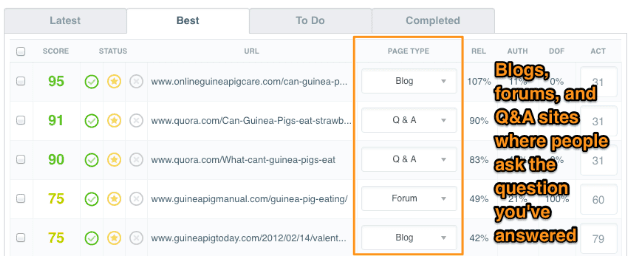Long a staple in the ecommerce store owner’s toolkit, blogger outreach is valued for its effectiveness in bolstering brand awareness and in building high quality links, contributing to that much coveted web authority. However, Google’s recent move to penalize bloggers for failing to use a nofollow tag on outbound links when reviewing a product or service that the blogger received for free should make ecommerce store owners rethink whether link building in this way is a safe, sustainable strategy for the long haul.
If exchanging free products for links is out, what other link building strategies do ecommerce store owners have at their disposal?
The four strategies below are proven approaches that the best ecommerce companies leverage to create content that is worth sharing.
1. Find Information Gaps
What questions are your potential customers asking? What is your area of expertise? Focus on creating content where these two intersect as a strategy for producing highly shareable content.

So how do you know what your potential customers are asking? Become acquainted with the places on the web your customers hang out, and over time you’ll encounter the questions and topics that your target customers are discussing. Quora, Reddit, the comment threads on the Facebook pages of your competitors, and more specialized forums that deal specifically with your niche are all good places to start.
However, as you look for ways to scale this strategy you’ll eventually want to use keyword research to help identify information gaps – that is, information that people are searching for, but that few websites are providing, or providing well.
Finding information gaps is the cornerstone of ecommerce store Small Pet Select’s content marketing strategy. An online supplier of hay and supplies for rabbits, guinea pigs, and chinchillas, Small Pet Select earns links from bloggers, pet stores, and pet communities alike by providing definitive answers to some of the questions most frequently asked by new small pet owners. And with 70% of Americans today having a pet in their home, there is a lot of search volume.
Small Pet Select found these information gaps using CanIRank’s keyword suggestion tool, but you can follow a similar process using whatever keyword research tool you prefer, including Google’s free Keyword Planner and Sheets, for those on a tight budget.
- The first step is to generate hundreds or even thousands of related keyword possibilities. For example, CanIRank generates these automatically based upon semantically-related keywords, your own website content, and the keywords sending the most traffic to your competitors. For SmallPetSelect this resulted in about 7,000 possibilities.
- Next, filter the possibilities down to only those containing a likely question word such as “what”, “where”, “why”, “can”, “how”, “does”, etc. Now we’re down to ~600 possibilities, ranking from common like “what do rabbits eat?” and “what is the best pet for toddlers?” to the more obscure “do guinea pigs like to watch TV?” and “how to fatten up a rabbit?”

- Finally, select topics to write about that offer the best balance between search volume and the difficulty of ranking for that keyword. Your goal is to address questions that aren’t already well-answered elsewhere.
- Lastly, once you’ve written a post thoroughly addressing a question, go back to the forums, blogs, and Q&A sites where you first noticed people asking this question and post a helpful response that includes your link as a reference. You can use Google to find these opportunities, or a dedicated link prospecting tool that will score prospects according to relevancy, authority, and whether or not they offer a dofollow link.

- The great part about this strategy is that once your answers are well ranked in the search engines, they’ll continually generate additional links on autopilot as these questions come up again and again, and people reference your post as a definitive answer to this question.

Another ecommerce store that does a great job of producing content to fill information gaps within its niche is Bavarian Clockworks – an online store that sells cuckoo clocks from Germany’s Black Forest region. As with many niche ecommerce retailers, it’s hard for Bavarian to earn links when most cuckoo clock-related content on the web is from competitors. So instead of focusing solely on cuckoo clocks, they expanded their focus to encompass Germany’s Black Forest region. This broader approach has given them the opportunity to answer questions on topics like how to make the best authentic Black Forest cake and what to do in Germany’s Black Forest. The underlying strategy here is to create linkbait for German culture enthusiasts and visitors to the Black Forest region, who would also make a natural customer base for cuckoo clocks.
2. Leverage Aligned Interests
Make a list of your store’s natural allies. Your list might include manufacturers of the products your store sells, your vendors, other businesses that purchase from you, or experts who work within your niche. Creating content that showcases your allies in a positive light means that there are others who have a vested interest in promoting your article or video or blog post.
But beyond having additional voices to amplify the reach of what you’ve created, think of your store’s allies as resources to help fill information gaps that you yourself might not have the expertise to fill yourself.
When I directed the ecommerce efforts of a popular wedding decorations shop, I used this strategy as often as possible. One of our most wildly successful pieces of content in the history of our store was a tutorial on how to make a boutonniere. Not knowing how to make one myself, I emailed a local florist who did the flowers at my own wedding, and asked if she’d be interested in working with me to create a tutorial.
The resulting product was something that not only filled an information gap that I would have been unable to do with my own expertise, but that our store’s ally was excited to link back to on her own website and to share with her social media communities. The content not only made it to the number one slot in the Google SERP, but is shown as a featured snippet.

Below are some of the many methods you can try out to leverage your store’s allies.
- A roundup post which features a collection of short responses from a group of experts is a content marketing tool that SEOs and marketers use all the time because beyond soliciting responses, it requires minimal effort spent on the content creation itself, and you instantly have a bunch of people eager to share this piece of content that they participated in creating. Roundup posts could work well for a number of ecommerce niches, such as Darren’s post on choosing a profitable ecommerce idea.
- Interviews or Q&As with experts in your niche are another format you can use when leveraging your store’s allies.
- Tutorials and How-To’s are other great ways to collaborate with your store’s allies. Because these can be time intensive to create, make sure you’re strategic in creating a guide that answers a question that people are already asking by using your favorite keyword tool.
3. Affirm a Worldview or Deeply Held Perspective
Checking my Facebook feed a few times a day has taught me that everyone loves sharing articles that help validate their own perspective.
Does your ecommerce store belong to a niche that caters to individuals who are passionate about a particular issue, cause, or lifestyle? Animal welfare, veganism, paleo and gluten free diets, CrossFit, dread disease awareness, sustainability, and fair trade are examples of such causes and lifestyles. By creating content that affirms how others see themselves or the world around them, you’re making use of an existing distribution network of people who want to promote awareness of something they care about.
True Goods – an online retailer of household goods and personal care products made with safe, sustainable materials – regularly practices a content strategy of affirming clean living and sustainability. And though True Goods is an ecommerce site, hardly a single post on the company’s blog makes an attempt – overtly, anyway – to sell you something. Instead, you’ll find articles with titles such as “Breast Cancer Linked to Plastics” and “Something’s Fishy with Farmed Fish” and “Going Green During Pregnancy.”

This isn’t a strategy that will work for every store – but if it’s a fit, it can be highly effective at attracting links and earning attention and shares on social media.
4. Be Controversial
While not for the faint of heart, being scrappy and controversial is another highly effective method to attract eyeballs and links alike. And while it may sound counterintuitive, it can actually be good for business to pick fight. Below are a few approaches to consider in trying this strategy.
- Compare and contrast. Is your product superior to the competitors’? Made in America vs China? Less expensive because you have lower overhead? Better quality because you don’t use shoddy materials? Don’t mistake this approach for the fluffy marketing you see on grocery store packaging. Dish out the truth with some well-reasoned arguments.
- Bust open myths. This approach to controversy allows you to challenge the conventional knowledge in your industry.
Check out the following examples of myth busting internet retailers.
Lems Shoes: Shoe Myths
Best Buy: Busting the Plasma TV Myths
The Cloth Diaper Shop: Cloth Diapering Myths - Piggy back on hot button topics of the day. While a somewhat riskier option, voicing your store’s stance on a controversial social or political topic can certainly get your store noticed.
One ecommerce presence that has made controversy really work for them is women’s clothier ModCloth. This is a company that is not bashful about constantly doing things that rile people up, from being one of the first well-known women’s brands to feature a transgender model, to declaring its anti-Photoshop stance, to proclaiming that every body is a “swimsuit body”. These things can and do alienate some potential customers, but they also create devoted brand evangelists, stir up engaging conversation, and attract a whole lot of links.

While there’s hardly anything easier than sending free product to a blogger in exchange for links and reviews, you may want to exercise caution pursuing that route going forward. However, if you’re clever about your content strategy, utilizing a combination of tactics that fit your store and your niche – you’ll find that you won’t have to beg, bribe, and bombard people to share because you’ll have created content that people actually want to link to.









